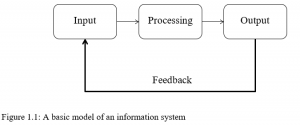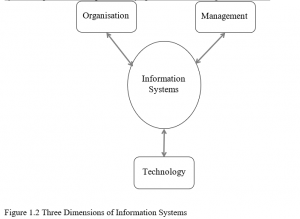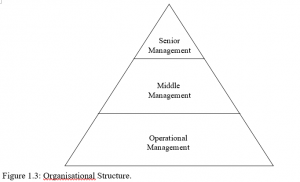Introduction to Information Systems
This purpose of this chapter is to introduce the role played by information systems and technology in business firms. The topics introduced in this chapter will be covered in detail in the remainder of the manual.
The objectives of this chapter are to:
- Explain why information systems are so essential in business today.
- Describe the digital economy and the digital firm
- Identify the business objectives for investing in information systems
- Define an information system from both a technical and a business perspective.
- Identify and describe the three dimensions of information systems – Organisation, management and information technology.
- Assess the other assets required for information technology to provide value to a business
- Describe the different approaches to the study of information systems:
– Technical approach – Behavioural approach – Sociotechnical systems
THE ROLE OF INFORMATION SYSTEMS IN BUSINESS TODAY
How Information Technology and Systems Are Transforming Business
Information systems are transforming business in a number of different ways. Information systems and the internet have dramatically cut the cost of acquiring and distributing information. The availability of information has increased the decision power of operational staff. The use of information systems has also made it easier for managers to monitor performance of staff. These two changes have contributed to a reduction in the number of middle managers and have lead to a general flattening of organisational structures.
Information technology and systems have enabled organisations to be more flexible. For example organisations such as the computer manufacturer, Dell, can support mass customisation of products without increasing costs. Companies are also linked electronically to suppliers enabling automatic triggering of orders, purchasing and payment thus reducing order times and also reducing stock holding costs.
Organisations are using real-time business intelligence and predictive analysis to enable faster decision-making and to cope with an ever changing market place where there are both threats and great opportunities.
Through its ease of use and countless advantages for enhancing business, the Internet has had a major impact on the globalisation of businesses.
Globalisation Opportunities
The Internet is now a global communications network that has dramatically reduced the cost of operating on a global scale. Customers can now shop in a global marketplace 24 hours a day, 7 days a week. Global business is no longer the preserve of large multinational enterprises. Even small businesses can use the internet to sell their products and services in other countries and even in other continents. Companies can use the Internet to reduce production expenses by sourcing low cost supplies and managing factories in other countries. Companies such as Facebook, Amazon and Google can use the Internet to duplicate their business models and services in many different countries.
The Digital Economy and the Digital Firm
In a 2011 research paper by Oxford Economics (supported by AT&T, Cisco, Citi, PwC and SAP) titled the “The Digital Economy”, it argues that the recent recession and financial crisis has speeded up the adoption of key technologies such as mobility, cloud computing, business intelligence and social media that are transforming businesses. Driven by the phenomenal growth of the internet we are now in a global digital economy. Over the next five years, many sectors, including technology, telecommunications, entertainment, media, banking, retail and healthcare, will continue to be reshaped through the application of information technology and systems. To survive and flourish in the digital economy, organisations will need to utilise technology to the fullest extent possible.
The digital firm is a term used to describe a company that has enabled its key business relationships with customers, suppliers, employees and business partners using digital networks and information systems. Information technology is also used widely throughout the organisation to support key functions and to manage internal processes. These information systems include Enterprise Resource Planning (ERP) Systems, Supply Chain Management (SCM) Systems, Customer Relationship Management (CRM) Systems and Knowledge Management Systems. The aim of the digital firm is to integrate functions and systems to enable the seamless exchange of information between internal employees and externally with suppliers, business partners and customers.
The term “The Digital Firm” was first used by Laudon, K. in his book Management Information Systems.
Business Objectives and Information Systems
Information systems are critical to supporting the day-to-day business in most organisations in the developed world. Some firms, such as Amazon, eBay and Facebook couldn’t exist without information systems. Some service industries such as finance, insurance and airlines could not operate without information systems. The ability of a firm to use Information technology and systems is closely linked with the firm’s ability to implement its business strategy.
There is a growing interdependence between a firm’s information systems and its business capabilities. Changes in strategy, rules and business processes increasingly require changes in hardware, software, databases and telecommunications. Often, what the organisation would like to do depends on what its systems will allow it to do.
Business firms invest in information systems to accomplish six primary strategic business objectives:
- Operational excellence: Efficiency, productivity and improved changes in business practices and management behaviour
- New products, services and business models: A business model describes how a company produces, delivers and sells a product or service to generate profit. Information systems and technologies create opportunities for products, services and new ways to engage in business.
- Customer and supplier intimacy: Improved communication and enhanced services to customers will help raise revenues. Closer relationships with suppliers will lead to lower costs of supplies.
- Improved decision making: Accurate and timely information is essential if business managers are to make the best possible decisions.
- Competitive advantage: Implementing effective and efficient information systems can allow a company to charge less than competitors for quality products, leading to higher sales and profits.
- Survival: Information systems can also be a necessity of doing business. A necessity may be driven by industry-level changes, such as the widespread adoption by many airlines of online booking of flights and check-in. A necessity may also be driven by governmental regulations, such as one requiring a business to retain data and report specific information for a period of time.
DIFFERENT PERSPECTIVES ON INFORMATION SYSTEMS
What is an Information System?
An information system is a set of interrelated parts that collect, process, store and distribute information to support decision making and control in an organisation. Information systems can also be used to analyse problems and to create new products and services.
Data and Information
Data is raw facts and figures, while information is data that has been processed or shaped into some useful forms for human use.
Raw data from a supermarket checkout counter point of sales system (POS) can be processed and organised to produce meaningful information, such as the total number of litres of milk sold in a particular shop during a particular period.
Attributes of Quality Information
For information to be useful to organisations it should possess certain attributes or qualities which include:
- Completeness: Information should be complete – in other words all information which is relevant to a decision should be provided.
- Accuracy: Information should be free of errors and bias. The degree of accuracy required is relative to the intended use of the information. For example an invoice must be accurate to the nearest RWF whereas a sales forecast might be rounded to the nearest RWF1000.
- Relevant for purpose: Information should be relevant to its purpose.
- Timely: Information needs to be up to date; information has little value if it is out of date.
- Reputable source: For information to be used effectively, the managers or users of the information must have confidence in the source of the information.
- Value: The value of the information should be greater than the cost of producing it. Information has value if it leads to decisions that reduce costs, eliminate losses, increase sales and allows for better utilisation of resources etc.
It is one of the challenges for Information System designers to produce information that is relevant, accurate and timely.
Input Processing and Output
Input, processing, and output are the three main activities in an information system. Input captures or collects raw data. Processing converts this raw input into a meaningful form. Output transfers the processed information to the people who will use it. Information systems also require feedback, which is output that is returned to help evaluate or refine the input stage. Feedback enables the system to control itself; this may involve modifying processing and/or input. See Figure 1.1.
For example, an Automatic Teller Machine (ATM) uses a number of input, processing and output cycles to perform its function. The initial input is the customer card details; this is processed by the ATM system. A message is output to the screen which asks the customer to input their Pin code after which the system processes this to check if it is correct. Another output to the screen asks the customer to input the services and amounts of money they want. After input and processing, the amount of money is output from the machine and a receipt may also be printed out.

Figure 1.1: A basic model of an information system
The different people who interact with an organisation’s information systems include customers, suppliers, business partners and regulatory agencies.
Dimensions of Information Systems
It is possible to distinguish information systems, which are designed to produce information and solve organisational problems, from the computer technology and software that is typically used to create and manage information systems.
Computer Literacy and Information Systems Literacy
Computer literacy focuses primarily on knowledge of information technology; i.e. on computer hardware and software. It involves understanding how computer technology works and operates; how technology is built and how it is programmed.
Information systems literacy focuses on an understanding of information systems; i.e. how the systems operate, their capabilities, how these systems can provide solutions to business problems and create information that is useful to the business and its employees. The field of management information systems (MIS) tries to achieve this broader information systems literacy.
Three Dimensions of Information Systems
Information systems are more than just technology; there are also management and organisational dimensions to information systems (see Figure 1.2). To be able to fully understand information systems and utilise them effectively requires an understanding of how systems impact and are impacted on by operational and management issues.

Figure 1.2 Three Dimensions of Information Systems
Organisation
Information systems are part of organisations, and in some cases (such as Internet companies), they are the organisation itself. Information systems will have the procedures and processes and the culture of an organisation imbedded within them.
The organisation structure consists of three main levels; each performing different duties and each using information systems for different purposes (See figure 1.3).
Senior management makes long-range strategic decisions and ensures the firm’s financial performance. Middle management carries out the plans of senior management and operational management monitors the firm’s daily activities. All these activities are enabled through information systems.
Specialists are employed in the major business functional areas such as sales and marketing, manufacturing and production, finance and accounting, and human resources. Work within each business function and between business functions is coordinated and enabled by detailed business processes. These processes are increasingly made possible by information systems.

Figure 1.3: Organisational Structure.
Management
Information systems supply tools and information needed by managers to manage their work and make decisions, in the case of both short and long term decisions. Information systems enable managers to monitor operations, analyse data, identify changes in the market place and help create new products and services.
Technology
Management uses technology (hardware, software, storage and telecommunications) to carry out their functions. Information technology is one of the many tools used by management to cope with change.
A firm’s information technology (IT) infrastructure is the platform on which an organisation can build its information systems. IT infrastructure consists of:
- Computer hardware: The physical equipment and computing devices used for input, storage, processing, output and telecommunications. For example; keyboards, monitors, processors, hard disks, modems etc.
- Computer software: The programs that control and coordinate the computer hardware components. Computer software would include operating systems such Windows and Unix.
- Data management software: This software controls the organisation of data on physical storage media.
- Networking and telecommunications technology: This is the hardware and software used to link various devices and transfer data from one location to another to enable the sharing of data such as files, images, sounds, video, or to share resources such as a printer.
Each of these topics listed above are discussed in detail later in this manual.
A Business Perspective on Information Systems
Information systems enable the firm to increase its revenue or decrease its costs by providing information that helps managers make better decisions or that improves the efficiency of business processes.
The value of an information system to a business is determined by how the use of the system will lead to better management decision making, more efficient business processes and ultimately to higher profits.
This business view of information systems highlights the link between the organisation (business process), management and information systems.
Information Technology Investments
Some organisations achieve better returns from their information systems investments than others. Studies of returns from information technology investments show that those firms that get lower return on investment are those that fail to adopt a new business model that better suits the new technology.
Research also found that information technology investments cannot make organisations and managers more effective unless they are accompanied by investments in complementary assets which include:
- Organisational assets: These include a supportive business culture that values efficiency and effectiveness, an appropriate business model, efficient business processes, decentralisation of authority and decision rights.
- Managerial assets: These include strong senior management support for change, incentive systems that monitor and reward individual innovation, an emphasis on teamwork and collaboration, training programs and a management culture that values flexibility and knowledge.
- Social assets: These are generally investments by governments, and other bodies in such areas as the Internet, educational system and regulations and laws.
Research indicates that firms that support their technology investments with investments in complementary assets, such as new business processes or training, receive higher returns.
DIFFERENT VIEWS OF INFORMATION SYSTEMS
Information systems are referred to as socio-technical systems. Although they are made up of technology, they require substantial input from people to make them work properly. Since problems with information systems and their solutions, are seldom either technical or behavioural, a multidisciplinary approach is needed.
Technical Approach
A technical approach to information systems emphasises the use of mathematical models to study information systems, the physical technology used to construct the systems and the capabilities of information systems. The areas of study that contribute to the technical approach are computer science, management science and operational research.
Behavioural Approach
The behavioural approach does not ignore technology, but tends to focus on non-technical areas. A behavioural approach to information systems focuses on questions such as strategic business integration, behavioural problems related to systems use, logical system design and implementation, social and organisational impacts of information systems, political impacts of information systems and individual responses to information systems. Solutions to problems created by information technology are primarily changes in attitudes, management, organisational policy and behaviour. The disciplines that contribute to the behavioural approach are psychology, sociology and economics.
A Socio-technical Systems Approach
The study of Management Information Systems (MIS) combines the work of computer science, management science and operations research with a practical focus towards developing system solutions to business problems. It is also concerned with behavioural issues surrounding the development, use and impact of information systems, which are typically discussed in the fields of sociology, economics and psychology.
In the sociotechnical view of systems, the best possible organisational performance is achieved by optimising both the social and technical systems used in production. Technology must be changed and designed to fit organisational and individual needs. Organisations and individuals must also be adapted through training, learning and planned organisational change to utilise the new technology as much as possible.
In a sociotechnical perspective, the performance of a system is optimised when both the technology and the organisation adjust to one another until a satisfactory fit is obtained.
D. MANAGEMENT CHALLENGES
Laudon & Laudon (2010) identifies five key management challenges involved in building, operating and maintaining information systems, which include the following:
- The strategic business challenge is how information technology can be used to design organisations so that are competitive, effective and digitally enabled.
- The globalisation challenge facing organisations is how organisations understand the system requirements of a global economic environment.
- The information architecture and infrastructure challenge is that organisations must be able to develop an information architecture that is able to support the company goals when both the business conditions and the technologies are changing so rapidly.
- The information systems investment challenge is how organisations determine the business value of systems.
- The responsibility and control challenge is how organisations can ensure that their information systems are used in an ethical and socially responsible way.
The topics discussed throughout this manual should provide the knowledge required to deal with these challenges.
